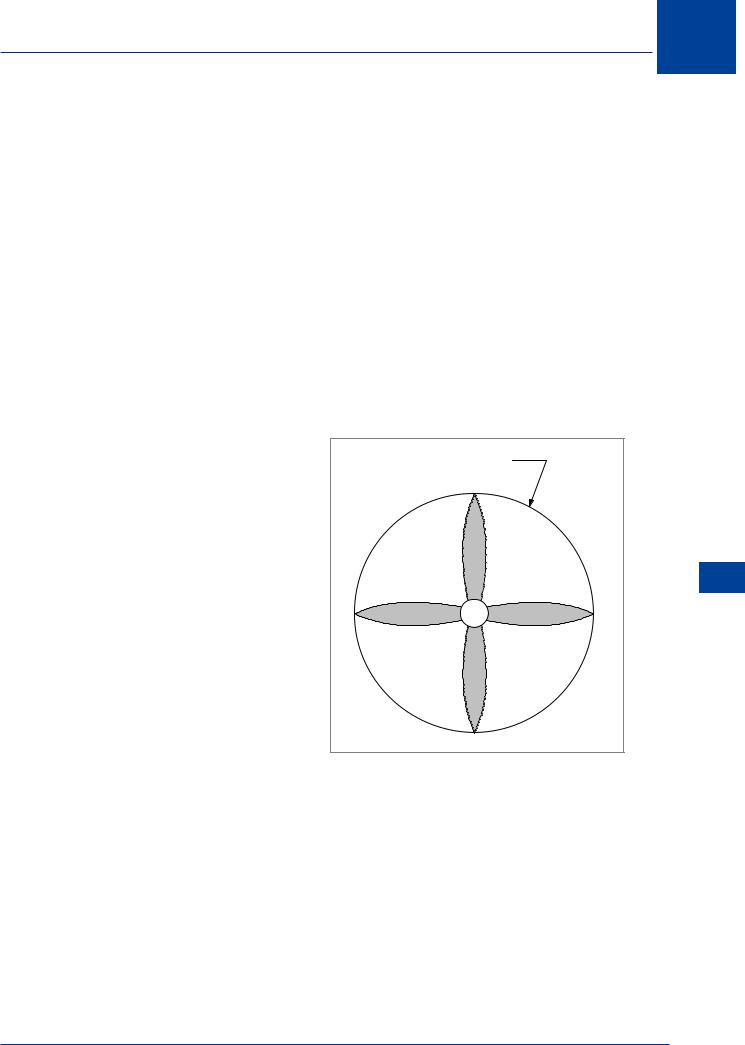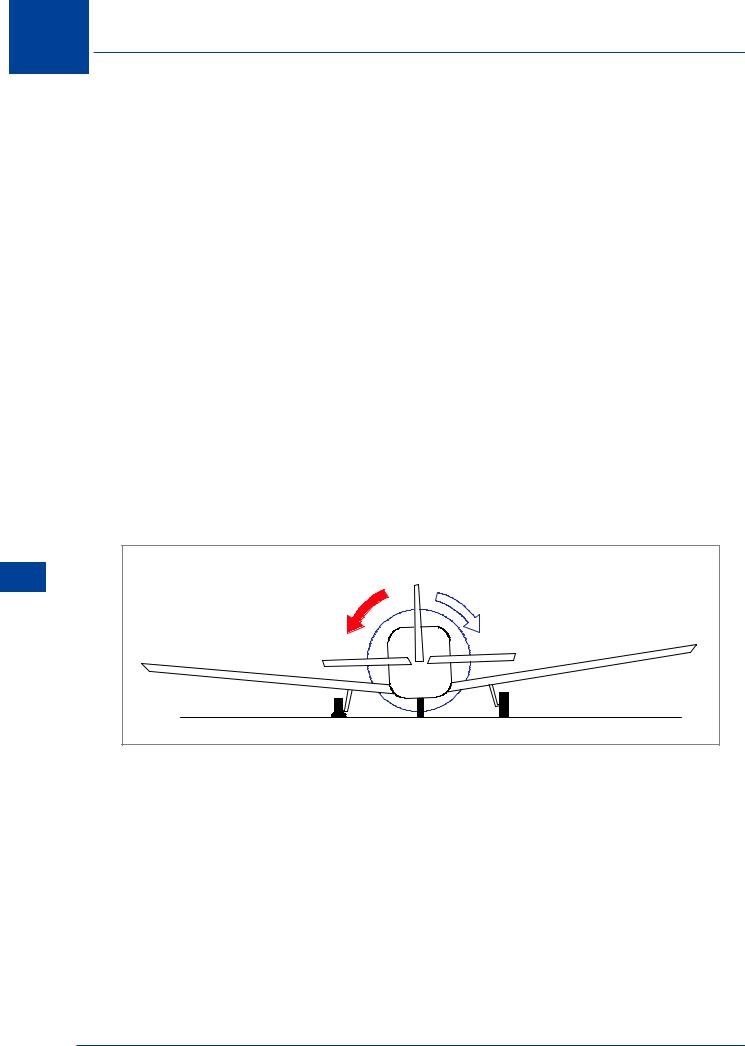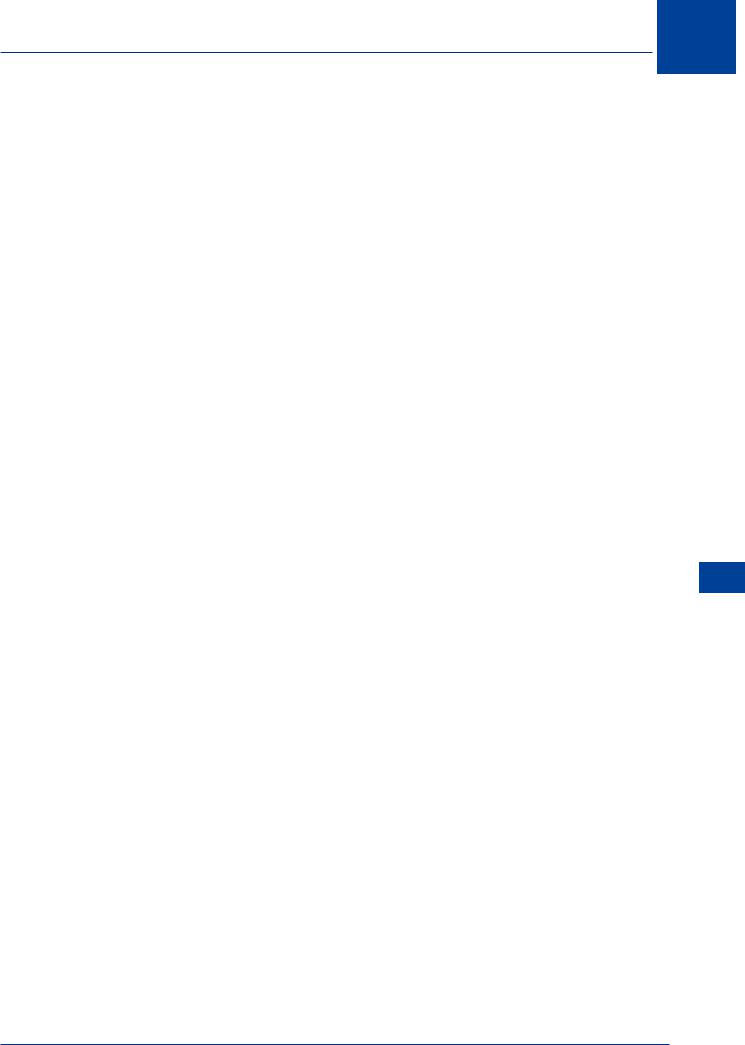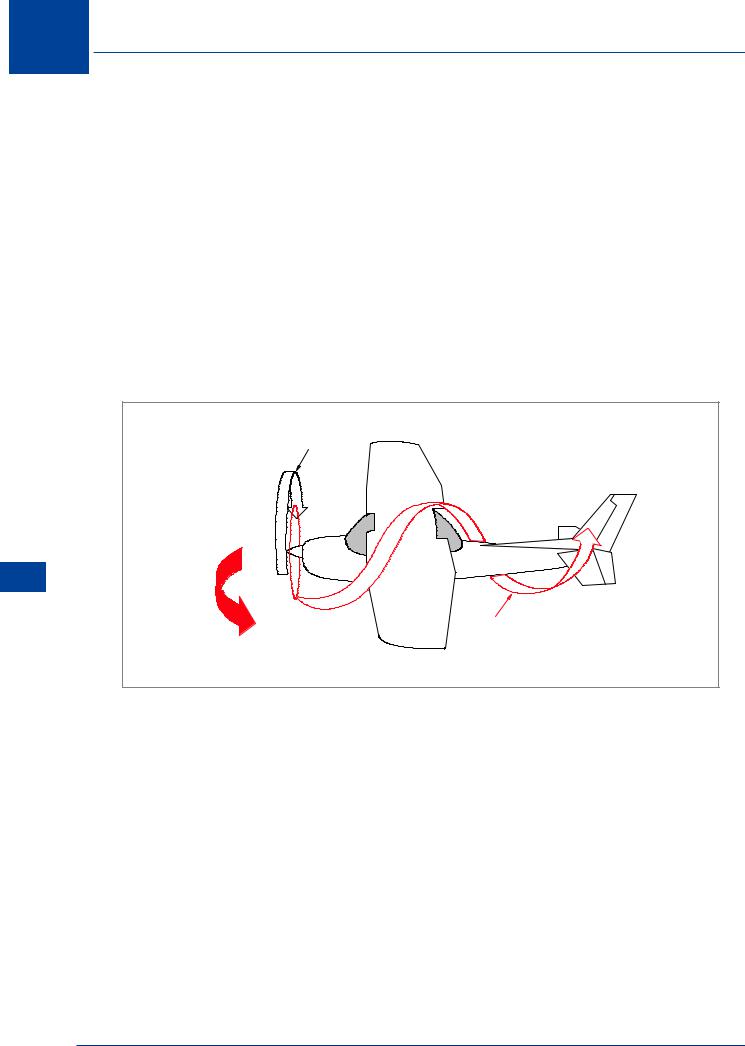
- •Textbook Series
- •Contents
- •1 Overview and Definitions
- •Overview
- •General Definitions
- •Glossary
- •List of Symbols
- •Greek Symbols
- •Others
- •Self-assessment Questions
- •Answers
- •2 The Atmosphere
- •Introduction
- •The Physical Properties of Air
- •Static Pressure
- •Temperature
- •Air Density
- •International Standard Atmosphere (ISA)
- •Dynamic Pressure
- •Key Facts
- •Measuring Dynamic Pressure
- •Relationships between Airspeeds
- •Airspeed
- •Errors and Corrections
- •V Speeds
- •Summary
- •Questions
- •Answers
- •3 Basic Aerodynamic Theory
- •The Principle of Continuity
- •Bernoulli’s Theorem
- •Streamlines and the Streamtube
- •Summary
- •Questions
- •Answers
- •4 Subsonic Airflow
- •Aerofoil Terminology
- •Basics about Airflow
- •Two Dimensional Airflow
- •Summary
- •Questions
- •Answers
- •5 Lift
- •Aerodynamic Force Coefficient
- •The Basic Lift Equation
- •Review:
- •The Lift Curve
- •Interpretation of the Lift Curve
- •Density Altitude
- •Aerofoil Section Lift Characteristics
- •Introduction to Drag Characteristics
- •Lift/Drag Ratio
- •Effect of Aircraft Weight on Minimum Flight Speed
- •Condition of the Surface
- •Flight at High Lift Conditions
- •Three Dimensional Airflow
- •Wing Terminology
- •Wing Tip Vortices
- •Wake Turbulence: (Ref: AIC P 072/2010)
- •Ground Effect
- •Conclusion
- •Summary
- •Answers from page 77
- •Answers from page 78
- •Questions
- •Answers
- •6 Drag
- •Introduction
- •Parasite Drag
- •Induced Drag
- •Methods of Reducing Induced Drag
- •Effect of Lift on Parasite Drag
- •Aeroplane Total Drag
- •The Effect of Aircraft Gross Weight on Total Drag
- •The Effect of Altitude on Total Drag
- •The Effect of Configuration on Total Drag
- •Speed Stability
- •Power Required (Introduction)
- •Summary
- •Questions
- •Annex C
- •Answers
- •7 Stalling
- •Introduction
- •Cause of the Stall
- •The Lift Curve
- •Stall Recovery
- •Aircraft Behaviour Close to the Stall
- •Use of Flight Controls Close to the Stall
- •Stall Recognition
- •Stall Speed
- •Stall Warning
- •Artificial Stall Warning Devices
- •Basic Stall Requirements (EASA and FAR)
- •Wing Design Characteristics
- •The Effect of Aerofoil Section
- •The Effect of Wing Planform
- •Key Facts 1
- •Super Stall (Deep Stall)
- •Factors that Affect Stall Speed
- •1g Stall Speed
- •Effect of Weight Change on Stall Speed
- •Composition and Resolution of Forces
- •Using Trigonometry to Resolve Forces
- •Lift Increase in a Level Turn
- •Effect of Load Factor on Stall Speed
- •Effect of High Lift Devices on Stall Speed
- •Effect of CG Position on Stall Speed
- •Effect of Landing Gear on the Stall Speed
- •Effect of Engine Power on Stall Speed
- •Effect of Mach Number (Compressibility) on Stall Speed
- •Effect of Wing Contamination on Stall Speed
- •Warning to the Pilot of Icing-induced Stalls
- •Stabilizer Stall Due to Ice
- •Effect of Heavy Rain on Stall Speed
- •Stall and Recovery Characteristics of Canards
- •Spinning
- •Primary Causes of a Spin
- •Phases of a Spin
- •The Effect of Mass and Balance on Spins
- •Spin Recovery
- •Special Phenomena of Stall
- •High Speed Buffet (Shock Stall)
- •Answers to Questions on Page 173
- •Key Facts 2
- •Questions
- •Key Facts 1 (Completed)
- •Key Facts 2 (Completed)
- •Answers
- •8 High Lift Devices
- •Purpose of High Lift Devices
- •Take-off and Landing Speeds
- •Augmentation
- •Flaps
- •Trailing Edge Flaps
- •Plain Flap
- •Split Flap
- •Slotted and Multiple Slotted Flaps
- •The Fowler Flap
- •Comparison of Trailing Edge Flaps
- •and Stalling Angle
- •Drag
- •Lift / Drag Ratio
- •Pitching Moment
- •Centre of Pressure Movement
- •Change of Downwash
- •Overall Pitch Change
- •Aircraft Attitude with Flaps Lowered
- •Leading Edge High Lift Devices
- •Leading Edge Flaps
- •Effect of Leading Edge Flaps on Lift
- •Leading Edge Slots
- •Leading Edge Slat
- •Automatic Slots
- •Disadvantages of the Slot
- •Drag and Pitching Moment of Leading Edge Devices
- •Trailing Edge Plus Leading Edge Devices
- •Sequence of Operation
- •Asymmetry of High Lift Devices
- •Flap Load Relief System
- •Choice of Flap Setting for Take-off, Climb and Landing
- •Management of High Lift Devices
- •Flap Extension Prior to Landing
- •Questions
- •Annexes
- •Answers
- •9 Airframe Contamination
- •Introduction
- •Types of Contamination
- •Effect of Frost and Ice on the Aircraft
- •Effect on Instruments
- •Effect on Controls
- •Water Contamination
- •Airframe Aging
- •Questions
- •Answers
- •10 Stability and Control
- •Introduction
- •Static Stability
- •Aeroplane Reference Axes
- •Static Longitudinal Stability
- •Neutral Point
- •Static Margin
- •Trim and Controllability
- •Key Facts 1
- •Graphic Presentation of Static Longitudinal Stability
- •Contribution of the Component Surfaces
- •Power-off Stability
- •Effect of CG Position
- •Power Effects
- •High Lift Devices
- •Control Force Stability
- •Manoeuvre Stability
- •Stick Force Per ‘g’
- •Tailoring Control Forces
- •Longitudinal Control
- •Manoeuvring Control Requirement
- •Take-off Control Requirement
- •Landing Control Requirement
- •Dynamic Stability
- •Longitudinal Dynamic Stability
- •Long Period Oscillation (Phugoid)
- •Short Period Oscillation
- •Directional Stability and Control
- •Sideslip Angle
- •Static Directional Stability
- •Contribution of the Aeroplane Components.
- •Lateral Stability and Control
- •Static Lateral Stability
- •Contribution of the Aeroplane Components
- •Lateral Dynamic Effects
- •Spiral Divergence
- •Dutch Roll
- •Pilot Induced Oscillation (PIO)
- •High Mach Numbers
- •Mach Trim
- •Key Facts 2
- •Summary
- •Questions
- •Key Facts 1 (Completed)
- •Key Facts 2 (Completed)
- •Answers
- •11 Controls
- •Introduction
- •Hinge Moments
- •Control Balancing
- •Mass Balance
- •Longitudinal Control
- •Lateral Control
- •Speed Brakes
- •Directional Control
- •Secondary Effects of Controls
- •Trimming
- •Questions
- •Answers
- •12 Flight Mechanics
- •Introduction
- •Straight Horizontal Steady Flight
- •Tailplane and Elevator
- •Balance of Forces
- •Straight Steady Climb
- •Climb Angle
- •Effect of Weight, Altitude and Temperature.
- •Power-on Descent
- •Emergency Descent
- •Glide
- •Rate of Descent in the Glide
- •Turning
- •Flight with Asymmetric Thrust
- •Summary of Minimum Control Speeds
- •Questions
- •Answers
- •13 High Speed Flight
- •Introduction
- •Speed of Sound
- •Mach Number
- •Effect on Mach Number of Climbing at a Constant IAS
- •Variation of TAS with Altitude at a Constant Mach Number
- •Influence of Temperature on Mach Number at a Constant Flight Level and IAS
- •Subdivisions of Aerodynamic Flow
- •Propagation of Pressure Waves
- •Normal Shock Waves
- •Critical Mach Number
- •Pressure Distribution at Transonic Mach Numbers
- •Properties of a Normal Shock Wave
- •Oblique Shock Waves
- •Effects of Shock Wave Formation
- •Buffet
- •Factors Which Affect the Buffet Boundaries
- •The Buffet Margin
- •Use of the Buffet Onset Chart
- •Delaying or Reducing the Effects of Compressibility
- •Aerodynamic Heating
- •Mach Angle
- •Mach Cone
- •Area (Zone) of Influence
- •Bow Wave
- •Expansion Waves
- •Sonic Bang
- •Methods of Improving Control at Transonic Speeds
- •Questions
- •Answers
- •14 Limitations
- •Operating Limit Speeds
- •Loads and Safety Factors
- •Loads on the Structure
- •Load Factor
- •Boundary
- •Design Manoeuvring Speed, V
- •Effect of Altitude on V
- •Effect of Aircraft Weight on V
- •Design Cruising Speed V
- •Design Dive Speed V
- •Negative Load Factors
- •The Negative Stall
- •Manoeuvre Boundaries
- •Operational Speed Limits
- •Gust Loads
- •Effect of a Vertical Gust on the Load Factor
- •Effect of the Gust on Stalling
- •Operational Rough-air Speed (V
- •Landing Gear Speed Limitations
- •Flap Speed Limit
- •Aeroelasticity (Aeroelastic Coupling)
- •Flutter
- •Control Surface Flutter
- •Aileron Reversal
- •Questions
- •Answers
- •15 Windshear
- •Introduction (Ref: AIC 84/2008)
- •Microburst
- •Windshear Encounter during Approach
- •Effects of Windshear
- •“Typical” Recovery from Windshear
- •Windshear Reporting
- •Visual Clues
- •Conclusions
- •Questions
- •Answers
- •16 Propellers
- •Introduction
- •Definitions
- •Aerodynamic Forces on the Propeller
- •Thrust
- •Centrifugal Twisting Moment (CTM)
- •Propeller Efficiency
- •Variable Pitch Propellers
- •Power Absorption
- •Moments and Forces Generated by a Propeller
- •Effect of Atmospheric Conditions
- •Questions
- •Answers
- •17 Revision Questions
- •Questions
- •Answers
- •Explanations to Specimen Questions
- •Specimen Examination Paper
- •Answers to Specimen Exam Paper
- •Explanations to Specimen Exam Paper
- •18 Index

Propellers 16
Power Absorption
A propeller must be able to absorb all the shaft power developed by the engine and also operate with maximum efficiency throughout the required performance envelope of the aircraft. The critical factor is tip velocity. If tip velocity is too high, the blade tips will approach the local speed of sound and compressibility effects will decrease thrust and increase rotational drag. Supersonic tip speed will considerably reduce the efficiency of a propeller and greatly increase the noise it generates.
This imposes a limit on propeller diameter and RPM, and the TAS at which it can be used.
Other limitations on propeller diameter are the need to maintain adequate ground clearance and the need to mount the engines of a multi-engine aircraft as close to the fuselage as possible to minimize the thrust arm. Increasing the propeller diameter requires the engine to be mounted further out on the wing to maintain adequate fuselage clearance. To keep VMC within acceptable limits, the available rudder moment would have to be increased. Clearly, increasing the propeller diameter to increase power absorption is not the preferred option.
Solidity
To increase power absorption, several characteristics of the propeller can be adjusted. The usual method is to increase the ‘solidity’ of the propeller. Propeller solidity is the ratio of the total frontal area of the blades to the area of the propeller disc. It can be seen from Figure 16.18 that an increase in solidity can be achieved by:
•Increasing the chord of each blade. This increases the solidity, but blade aspect ratio is reduced, making the propeller less efficient.
•Increasing the number of blades. Power absorption is increased without increasing tip speed or reducing the aspect ratio.
Increasing the number of blades beyond a certain number (five or six) will reduce overall efficiency.
PROPELLER DISC |
Figure 16.18 Solidity of a propeller
Thrust is generated by accelerating air rearwards. Making the disk too solid will reduce the mass of air that can be drawn through the propeller and accelerated. To increase the number of blades efficiently, two propellers rotating in opposite directions on the same shaft are used. These are called contra-rotating propellers.
Propellers 16
513

16 Propellers
Moments and Forces Generated by a Propeller
Due to its rotation a propeller generates yawing, rolling and pitching moments. These are due to several different causes:
•Torque reaction.
•Gyroscopic precession.
•Spiral (asymmetric) slipstream effect.
•Asymmetric blade effect.
Note: The majority of modern engines are fitted with propellers which rotate clockwise when viewed from the rear, so called “right-hand” propellers. The exceptions are small twin piston engine aircraft, which often have the propeller of the right engine rotating anti-clockwise to eliminate the disadvantage of having a “critical engine” (see Chapter 12), plus some older aircraft.
Torque Reaction
Because the propeller rotates clockwise, the equal and opposite reaction (torque) will give the aircraft an anti-clockwise rolling moment about the longitudinal axis. During take-off this will apply a greater down load to the left wheel, Figure 16.19, causing more rolling resistance on the left wheel making the aircraft want to yaw to the left. In flight, torque reaction will also make the aircraft want to roll to the left. Torque reaction will be greatest during high power, low airspeed (IAS) flight conditions. Low IAS will reduce the power of the controls to counter the “turning” moment due to torque.
16 |
|
PROPELLER |
|
|
TORQUE |
||
Propellers |
ROTATION |
||
|
|||
|
|
Figure 16.19 Torque reaction giving left turn during take-off
Torque reaction can be eliminated by fitting contra-rotating propellers. Torque from the two propellers, rotating in opposite directions on the same shaft, will cancel each other out. Co-rotating propellers on a small twin will not normally give a torque reaction until one engine fails. A left “turning” tendency would then occur. Counter-rotating propellers on a small twin will reduce the torque reaction following an engine failure.
514

Propellers 16
Gyroscopic Effect
A rotating propeller has the properties of a gyroscope - rigidity in space and precession. The characteristic which produces “gyroscopic effect” is precession. Gyroscopic precession is the reaction that occurs when a force is applied to the rim of a rotating disc. When a force is applied to the rim of a propeller, the reaction occurs 90° ahead in the direction of rotation and in the same direction as the applied force. As the aircraft is pitched up or down or yawed left or right, a force is applied to the rim of the spinning propeller disc.
Note: Gyroscopic effect only occurs when the aircraft pitches and/or yaws.
For example, if an aircraft with a clockwise rotating propeller is pitched nose-up, imagine that a forward force has been applied to the bottom of the propeller disc. The force will “emerge” at 90° in the direction of rotation, i.e. a right yawing moment. Gyroscopic effect can be easily determined when the point of application of the imagined forward force on the propeller disc is considered.
Pitch down - forward force on the top, force emerges 90° clockwise, left yaw.
Left yaw - forward force on the right, force emerges 90° clockwise, pitch up.
Right yaw - forward force on the left, force emerges 90° clockwise, pitch down.
Gyroscopic effect will be cancelled if the propellers are contra-rotating.
Propellers 16
515

16
Propellers 16
Propellers
Spiral Slipstream Effect
As the propeller rotates it produces a backward flow of air, or slipstream, which rotates around the aircraft, as illustrated in Figure 16.20. This spiral slipstream causes a change in airflow around the fin (vertical stabilizer). Due to the direction of propeller rotation (clockwise) the spiral slipstream meets the fin at an angle from the left, producing a sideways force on the fin to the right.
Spiral slipstream effect gives the aircraft a yawing moment to the left.
The amount of rotation given to the air will depend on the throttle and RPM setting. Spiral slipstream effect can be reduced by:
•the use of contra or counter-rotating propellers.
•a small fixed tab on the rudder.
•the engine thrust line inclined slightly to the right.
•offsetting the fin slightly.
PROPELLER ROTATION
SPIRAL SLIPSTREAM
LEFT YAW
Figure 16.20 Spiral slipstream effect
516
